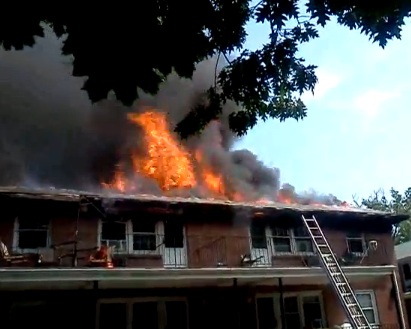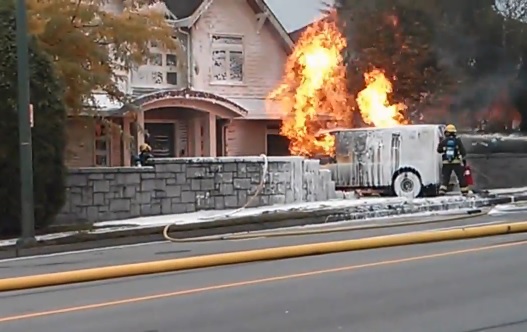A story about something that didn’t happen the day the World Trade Center was bombed
Looking for a quality used fire truck? Selling one? Visit our sponsor Command Fire Apparatus
Twenty-five years ago this morning – a Friday – the phone rang early. The call was probably just before 6:00. On the line was a source from the Bureau of Alcohol, Tobacco and Firearms. He told me the raid was off.
On February 26, 1993, ATF agents were supposed to gather near Hillsboro, West Virginia for the serving of a search warrant the next morning. Hillsboro is best known as the childhood home of famed novelist Pearl Buck. ATF was after a novelist of a different sort. His name was William Luther Pierce.
William Pierce was the white supremacist who founded the National Alliance. Under the name Andrew Macdonald, Pierce wrote a 1978 book considered the bible for white supremacists. “The Turner Diaries”, among other things, is about race wars in the United States and the overthrow of our government. The New York Times described the book as racist and anti-Semitic. The book was inspiration for Timothy McVeigh’s 1995 bombing of the Alfred P. Murrah Federal Building in Oklahoma City that killed 168 people, including 19 children.
ATF was interested in Pierce because an assault rifle connected to a man involved in a threat against President Bill Clinton was traced back to the National Alliance compound in Hillsboro. The compound was located on 364 acres Pierce purchased in 1984.
I had been reporting on ATF since the abortion clinic bombings in the Washington area in the early 1980s. It was not unusual to be tipped about an upcoming operation from federal law enforcement, particularly ATF. That was about to change thanks to an event just 48-hours later.
ATF agents discovered that an article about the man who had been arrested in the Clinton threat was published in Norfolk’s Virginian Pilot. That small story, in a newspaper 300 hundred miles away, had enough specifics that Patrick Hines, the special agent in charge of ATF’s Washington Field Office, believed it could possibly remove the element of surprise. Hines did not want to put the agents under his command in additional danger in what was already considered a high risk warrant.
I called the WUSA-TV assignment desk and videographer Frank McDermott with word the West Virginia trip was off. Frank had already rented a four-wheel drive vehicle because of snow in the forecast. Since Friday was normally my day off, I went back to sleep.
About six hours later I was eating lunch and watching TV when the first images of the bombing at the World Trade Center appeared. The phone rang a short time later. The assignment desk wanted me to meet videographer Greg Guise at Union Station. They hoped to have me live from Manhattan for the early evening newscasts.
By the time Greg and I arrived at the bombing site, things were well under control. Six people had died and more than a thousand were injured. We got in on the end of a briefing by Police Commissioner Raymond Kelly and interviewed some witnesses. On the air, I talked about the remarkable effort in treating so many patients.
I can’t say I have any special insight to share about our coverage from New York through the weekend other that an unusual situation Sunday morning. Greg and I followed a group of news photographers down the ramp into the garage area where the bombing occurred. We were able to get a minute or so of footage of the damage before NYPD came in and chased everyone away. To this day, I can’t explain why the area wasn’t roped off or guarded.
It was late Sunday afternoon when the other memorable image of the weekend occurred. Greg and I were at the CBS Broadcast Center on West 57th Street feeding in our report for the evening newscast at WUSA-TV. Looking through the window of a control room near where we worked, I could see video on a monitor of ATF agents on the roof of a large home. There was gunfire and agents were falling. My first thought was the William Pierce raid occurred without us. A CBS producer told me a few minutes later the video was from Waco, Texas. It was just being fed in for the CBS Evening News by KWTX-TV, the Waco affiliate.
Four ATF agents were killed and 16 wounded in the raid on the Branch Davidian compound. Besides the obvious horror and concern about those shot in Waco, my other reaction watching the chilling video was a rather selfish reporter observation. I told Greg that we had likely gone on our last raid with federal law enforcement. It wasn’t long before Attorney General Janet Reno made that official policy.
We learned later the Waco raid had originally been planned for the next day, Monday, March 1. A series of articles about the Branch Davidians started running in the local paper on Saturday and ATF in Texas decided to move up their action by a day.
After those details emerged, and to this day, anytime the raid at Waco comes up I think of Pat Hines. Pat didn’t want to risk that a tiny article in a newspaper hundreds of miles from the target’s home compromised his operation. A day later, different ATF supervisors made the opposite decision when faced with a front page story in their target’s hometown newspaper. It’s hard not to wonder how things would have turned out if Pat Hines had been making the decisions in Waco.







